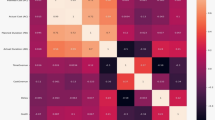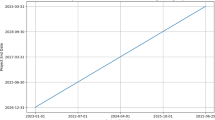Abstract
This research provides evidence of well-established evaluation frameworks for predicting time and cost overruns. There have been several attempts to reduce this issue, but these overruns still harm the construction industry worldwide. To create hyper-parameter-optimized predictive models, the numerical data was primarily used to train a specific type of machine learning algorithm known as an artificial neural network (ANN). In addition, Tabu Search was used to fine-tune the neural networks. Tabu Search returned a precision of 68.15826416015625, a recall of 80.6761884689331, and an accuracy of 92.19601929187775. The F1 score was 71.0405363922119. To better understand the occurrence of cost and schedule overruns, the study addressed in this article analyses 191 construction projects completed in the Hashemite Kingdom of Jordan between 2011 and 2021. The results showed that the R2 value was 0.938478 and the mean absolute error (MAE) was 0.057 for the data on cost overruns, while it was 0.9385 and the MAE was 21.7090 for the data on time overruns. Using tabular search optimization, the ANN model achieves better results than the baseline models. In sum, the neural network with tabular search optimization has proven to be a practical tool to employ in the early design phase, when there is typically a sparse or insufficient data set to conduct a cost and time overrun analysis. This approach has the potential to produce more reliable results and reduce the margin of error in estimates.










Similar content being viewed by others
References
Akinosho, T. D., Oyedele, L. O., Bilal, M., Ajayi, A. O., Delgado, M. D., Akinade, O. O., & Ahmed, A. A. (2020). Deep learning in the construction industry: A review of present status and future innovations. Journal of Building Engineering, 32, 101827. https://doi.org/10.1016/j.jobe.2020.101827
Al Yamani, W. H., Ghunimat, D. M., & Bisharah, M. M. (2023). Modeling and predicting the sensitivity of high-performance concrete compressive strength using machine learning methods. Asian Journal of Civil Engineering. https://doi.org/10.1007/s42107-023-00614-4
Alshboul, O., Alzubaidi, M. A., Mamlook, R. E., Almasabha, G., Almuflih, A. S., & Shehadeh, A. (2022). Forecasting liquidated damages via machine learning-based modified regression models for highway construction projects. Sustainability, 14(10), 5835. https://doi.org/10.3390/su14105835
Al-Tawal, D., Arafah, M., & Sweis, G. (2020). A model utilizing the artificial neural network in cost estimation of construction projects in Jordan. Engineering, Construction and Architectural Management, 28(9), 2466–2488. https://doi.org/10.1108/ecam-06-2020-0402
Alzebdeh, K., Bashir, H. A., & Al Siyabi, S. K. (2015). Applying interpretive structural modeling to cost overruns in construction projects in the Sultanate of Oman. The Journal of Engineering Research [TJER], 12(1), 53. https://doi.org/10.24200/tjer.vol12iss1pp53-68
Arantes, A., & Ferreira, L. M. (2020). Underlying causes and mitigation measures of delays in construction projects. Journal of Financial Management of Property and Construction, 25(2), 165–181. https://doi.org/10.1108/jfmpc-03-2019-0029
Asadi, A., Alsubaey, M., & Makatsoris, C. (2015). A machine learning approach for predicting delays in construction logistics. International Journal of Advanced Logistics, 4(2), 115–130. https://doi.org/10.1080/2287108x.2015.1059920
Ashtari, M. A., Ansari, R., Hassannayebi, E., & Jeong, J. (2022). Cost overrun risk assessment and prediction in Construction Projects: A Bayesian network classifier approach. Buildings, 12(10), 1660. https://doi.org/10.3390/buildings12101660
Assaad, R., & El-Adaway, I. H. (2021). Guidelines for responding to COVID-19 pandemic: Best practices, impacts, and future research directions. Journal of Management in Engineering. https://doi.org/10.1061/(asce)me.1943-5479.0000906
Baduge, S. K., Thilakarathna, S., Perera, J. S., Arashpour, M., Sharafi, P., Teodosio, B., Shringi, A., & Mendis, P. (2022). Artificial Intelligence and smart vision for building and Construction 4.0: Machine and Deep Learning Methods and Applications. Automation in Construction, 141, 104440. https://doi.org/10.1016/j.autcon.2022.104440
Berg, J. B., Thuesen, C., Ernstsen, S. K., & Jensen, P. A. (2021). Reconfiguring the construction value chain: Analysing key sources of friction in the business model archetypes of AEC Companies in strategic partnerships. Construction Management and Economics, 39(6), 533–548. https://doi.org/10.1080/01446193.2021.1925134
Btoush, M., & Harun, A. (2017). Minimizing delays in the Jordanian construction industry by adopting BIM technology. IOP Conference Series: Materials Science and Engineering, 271, 012041. https://doi.org/10.1088/1757-899x/271/1/012041
Budayan, C., et al. (2018). A computerized method for delay risk assessment based on fuzzy set theory using MS ProjectTM. KSCE Journal of Civil Engineering, 22, 1–12.
Cevikbas, M., Okudan, O., & Işık, Z. (2022). Identification and assessment of disruption claim management risks in construction projects: A life cycle-based approach. Engineering, Construction and Architectural Management. https://doi.org/10.1108/ecam-05-2022-0470
Chapman, R. J. (2001). The controlling influences on effective risk identification and assessment for construction design management. International Journal of Project Management, 19(3), 147–160. https://doi.org/10.1016/s0263-7863(99)00070-8
Cheng, M.-Y., & Hoang, N.-D. (2014). Groutability prediction of microfine cement based soil improvement using evolutionary LS-SVM inference model. Journal of Civil Engineering and Management, 20(6), 839–848.
Choudhury, I., & Phatak, O. (2004). Correlates of time overrun in commercial construction. In ASC Proceeding of 4th Annual Conference, Brigham Young University-Provo-Utah, April (pp. 8–10).
Egwim, C. N., Alaka, H., Toriola-Coker, L. O., Balogun, H., & Sunmola, F. (2021). Applied artificial intelligence for predicting construction projects delay. Machine Learning with Applications, 6, 100166. https://doi.org/10.1016/j.mlwa.2021.100166
El-adaway, I. H., Abotaleb, I. S., Eid, M. S., May, S., Netherton, L., & Vest, J. (2018). Contract administration guidelines for public infrastructure projects in the United States and Saudi Arabia: Comparative analysis approach. Journal of Construction Engineering and Management. https://doi.org/10.1061/(asce)co.1943-7862.0001472
El-Kholy, A. M. (2015). Predicting cost overrun in construction projects. International Journal of Construction Engineering and Management, 4(4), 95–105.
Fadhali, A. L. N. (2022). An AMOS-SEM approach to & nbsp;evaluating stakeholders’ influence on construction project & nbsp; delivery performance. Engineering, Construction and Architectural Management. https://doi.org/10.1108/ecam-09-2021-0780
Fobiri, G., Musonda, I., & Muleya, F. (2022). Reality capture in Construction Project Management: A review of opportunities and challenges. Buildings, 12(9), 1381. https://doi.org/10.3390/buildings12091381
Gunduz, M., Nielsen, Y., & Ozdemir, M. (2015). Fuzzy assessment model to estimate the probability of delay in Turkish construction projects. Journal of Management in Engineering, 31(4), 04014055.
Hegazy, T., & Ayed, A. (1998). Neural network model for parametric cost estimation of highway projects. Journal of Construction Engineering and Management, 124(3), 210–218.
Hwang, B. G., Ngo, J., & Teo, J. Z. (2022). Challenges and strategies for the adoption of smart technologies in the construction industry: The case of singapore. Journal of Management in Engineering. https://doi.org/10.1061/(asce)me.1943-5479.0000986
Kabirifar, K., & Mojtahedi, M. (2019). The impact of Engineering, Procurement and Construction (EPC) phases on Project Performance: A case of large-scale residential construction project. Buildings, 9(1), 15. https://doi.org/10.3390/buildings9010015
Kaveh, A., & Khalegi, A. (1998). Prediction of strength for concrete specimens using artificial neural networks. Advances in Engineering Computational Technology, 165–171.
Kaveh, A. (2014). Advances in metaheuristic algorithms for optimal design of structures (pp. 9–40). Springer International Publishing.
Kaveh, A., Gholipour, Y., & Rahami, H. (2008). Optimal design of transmission towers using genetic algorithm and neural networks. International Journal of Space Structures, 23(1), 1–19.
Kaveh, A., & Khavaninzadeh, N. (2023). Efficient training of two ANNs using four meta-heuristic algorithms for predicting the FRP strength. In Structures, 52, 256–272.
Kaveh, A., & Rad, A. S. (2023). Metaheuristic-based optimal design of truss structures using algebraic force method. In Structures, 50, 1951–1964.
Kaveh, A., & Servati, H. (2001). Design of double layer grids using backpropagation neural networks. Computers & Structures, 79(17), 1561–1568.
Khair, K., Mohamed, Z., Mohammad, R., Farouk, H., & Ahmed, M. E. (2018). A management framework to reduce delays in road construction projects in Sudan. Arabian Journal for Science and Engineering, 43(4), 1925–1940.
Kholif, W., Hosny, H., & Sanad, A. (2013). Analysis of time and cost overruns in educational building projects in Egypt. International Journal of Engineering and Technical Research, 1(10), 1–8.
Kim, H., Soibelman, L., & Grobler, F. (2008). Factor selection for delay analysis using knowledge discovery in databases. Automation in Construction, 17(5), 550–560. https://doi.org/10.1016/j.autcon.2007.10.001
Mohamad, H. M., Mohamad, M. I., Saad, I., Bolong, N., Mustazama, J., & Mohd Razali, S. N. (2021). A case study of S-curve analysis: Causes, effects, tracing and monitoring project extension of Time. Civil Engineering Journal, 7(4), 649–661. https://doi.org/10.28991/cej-2021-03091679
Musarat, M. A., Alaloul, W. S., & Liew, M. S. (2021). Impact of inflation rate on Construction Projects Budget: A Review. Ain Shams Engineering Journal, 12(1), 407–414. https://doi.org/10.1016/j.asej.2020.04.009
Parikh, D., Joshi, G. J., & Patel, D. A. (2019). Development of prediction models for claim cause analyses in highway projects. Journal of Legal Affairs and Dispute Resolution in Engineering and Construction. https://doi.org/10.1061/(asce)la.1943-4170.0000303
Polat, G., Bingol, B., Gurgun, A., & Yel, B. (2016). Comparison of ANN and MRA Approaches to Estimate Bid Mark-up Size in Public Construction Projects. Procedia Engineering, 164, 331–338. https://doi.org/10.1016/j.proeng.2016.11.627
Raschka, S., Patterson, J., & Nolet, C. (2020). Machine learning in Python: Main developments and technology trends in Data Science, Machine Learning, and Artificial Intelligence. Information, 11(4), 193. https://doi.org/10.3390/info11040193
Romzi, N. A., & Shu Ing, D. (2022). Underlying causes of construction project delay: A review. Construction, 2(2), 07–11. https://doi.org/10.15282/construction.v2i2.7775
Santoso, D. S., & Gallage, P. G. (2019). Critical factors affecting the performance of large construction projects in developing countries. Journal of Engineering, Design and Technology, 18(3), 531–556. https://doi.org/10.1108/jedt-05-2019-0130
Tummalapudi, M., Harper, C. M., Taylor, T. R. B., Waddle, S., & Catchings, R. (2022). Causes, implications, and strategies for project closeout delays in highway construction. Transportation Research Record: Journal of the Transportation Research Board, 2676(9), 479–490. https://doi.org/10.1177/03611981221087229
Ujong, J., Mbadike, E., & Alaneme, G. (2022). Prediction of cost and duration of building construction using artificial neural network. Asian Journal of Civil Engineering, 23(7), 1117–1139. https://doi.org/10.1007/s42107-022-00474-4
Funding
The authors did not receive support from any organization for the submitted work. Data availability the data that support the findings of this study are available from the corresponding author, [Rakan Al mnaseer], upon reasonable request.
Author information
Authors and Affiliations
Contributions
AB and CD wrote the main manuscript text and EF prepared figures . All authors reviewed the manuscript."
Corresponding author
Ethics declarations
Conflict of interest
All authors certify that they have no affiliations with or involvement in any organization or entity with financial interest or non-financial interest in the subject matter or materials discussed in this manuscript.
Additional information
Publisher's Note
Springer Nature remains neutral with regard to jurisdictional claims in published maps and institutional affiliations.
Rights and permissions
Springer Nature or its licensor (e.g. a society or other partner) holds exclusive rights to this article under a publishing agreement with the author(s) or other rightsholder(s); author self-archiving of the accepted manuscript version of this article is solely governed by the terms of such publishing agreement and applicable law.
About this article
Cite this article
Al mnaseer, R., Al-Smadi, S. & Al-Bdour, H. Machine learning-aided time and cost overrun prediction in construction projects: application of artificial neural network. Asian J Civ Eng 24, 2583–2593 (2023). https://doi.org/10.1007/s42107-023-00665-7
Received:
Accepted:
Published:
Issue Date:
DOI: https://doi.org/10.1007/s42107-023-00665-7




